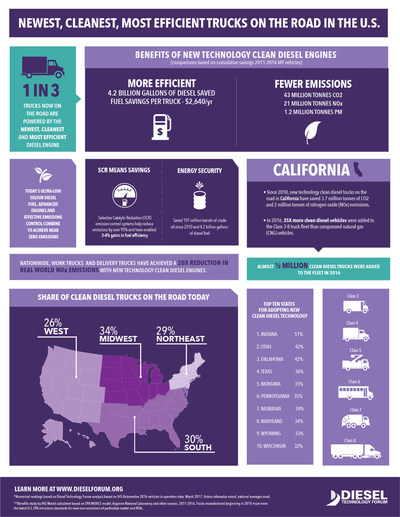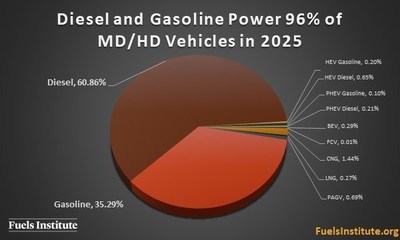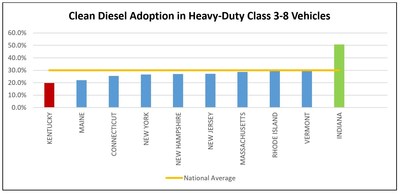NEWARK, N.J., Sept. 25, 2017 /PRNewswire-USNewswire/ -- Eight states in the Northeast are set to receive approximately $306 million as part of the emissions settlement from the Volkswagen (VW) Environmental Mitigation Trust. This money is earmarked for projects that immediately reduce emissions of oxides of nitrogen (NOx), so as to mitigate the excessive NOx generated by diesel VW cars operating in these states.



Applying VW settlement funds to replace or update the largest and oldest trucks, industrial marine and locomotive engines in the Northeast with the newest clean diesel technology would yield immediate and significant NOx benefits at the lowest cost per ton, compared to electrification and other as-yet commercially widespread technologies.
"Regulators across the Northeast must recognize the current and future role of diesel technology in the global goods movement sector, and the substantial, immediate clean air and climate benefits that come from the accelerated adoption of the latest clean diesel technology," said Ezra Finkin, Director of Policy and External Relations at the Diesel Technology Forum (the Forum), speaking at the Northeast Diesel Collaborative Partners Meeting (Sep. 25-26, Newark, N.J.). "East Coast communities near manufacturing hubs, shipping/trucking throughways and ports will benefit the most from accelerating the introduction of newer clean diesel technology in emission reduction."
The Northeast represents a significant sector for U.S. heavy-duty trucking. Trucks registered in these eight states (Connecticut, Maine, Massachusetts, New Hampshire, New Jersey, New York, Rhode Island and Vermont) make up 10 percent of the nation's 5.6 million-vehicle commercial fleet. Plus, nearly 10 percent of the nation's diesel engines are manufactured there.
Because of its unique combination of power, performance, efficiency, reliability, durability and availability, diesel power is projected to remain the dominant technology for global goods movement on land and sea by a number of forecasters. The Fuels Institute, using analysis from Navigant Research, predicts that by 2025 diesel will still be the predominant engine type powering commercial vehicles. Battery electric, fuel cell and natural gas powertrains will only make up about 3 percent of the commercial vehicle fleet. The newest generation of clean diesel technology achieves near-zero levels of NOx emissions and particulate matter emissions, while also maintaining an efficiency and performance advantage over other fuels.
"Diesel is the technology of choice for commercial trucking, marine and rail applications, and the benefits of the new generation of technology offer the Northeast states the fastest and most proven way to cleaner air and reduced greenhouse gas emissions," said Allen Schaeffer, executive director of the Forum. "Nearly 3 million heavy-duty diesel commercial vehicles powered by the latest generation clean diesel engines are on the road today. These new generation trucks have already delivered important benefits: cleaner air, fewer carbon dioxide emissions and dramatic fuel savings. Nationally, over a five-year period, the newest generation commercial vehicles reduced 43 million tonnes of carbon dioxide, removed 21 million tonnes of NOx and eliminated 1.2 million tonnes of particulate matter. If these are the results from conversion of just one third of the U.S. truck fleet, just imagine what benefits could be brought about as more commercial vehicle operators choose clean diesel technologies."
As states consider future technology investments, upgrading or replacing older vehicles, equipment, switch locomotives and harbor craft with the latest clean diesel technology will do the most to deliver needed emission reductions to sensitive communities most in need of emission reductions in a timely and cost-effective manner.
According to the U.S. Department of Transportation, using the latest emissions model generated by the U.S. Environmental Protection Agency (EPA), one ton of NOx emissions may be eliminated by investing, on average, $20,000 in clean diesel technology versus $1 million in alternative fuel infrastructure. Moreover, according to the EPA's most recent National Port Strategy Assessment (December 2016):
- Replacing a model year 2007 Class 8 drayage truck with a model year 2010 or newer diesel drayage truck can reduce NOx emissions by 221 lbs.
- Replacing a single old engine that powers a switch locomotive with a Tier 4 model can reduce NOx emissions by 37,000 lbs. of NOx and 974 lbs. of particulate matter emissions. Replacing the older engine in the wide variety of marine workboats including tugs and ferries can have equally significant emissions reductions.
"These significant emission reductions could be delivered immediately by technology that is sitting on dealer lots today, which does not require the lengthy and expensive buildout of refueling or recharging infrastructure, or the widespread adoption of technologies not yet available at a commercial market scale," said Schaeffer. "Further, states can immediately enhance this proven clean air performance and achieve significant greenhouse gas reduction capabilities by utilizing low-carbon renewable diesel fuel in all its diesel engines and equipment."
The newest generation of clean diesel trucks have NOx emissions that are 99 percent lower than previous generations, along with 98 percent fewer emissions of particulate matter. Beginning in 2011, all heavy-duty diesel trucks sold had to meet NOx emissions of no more than 0.20 grams per brake horse-power hour (g/BHP-hr). This is in addition to particulate emissions levels of no more than 0.01 g/BHP-hr, as established in 2007.
Fast Facts
- Trucks registered in the eight Northeast states comprise 10 percent of the nation's 5.6 million-vehicle commercial fleet.
- About 73 percent of Northeast trucks – more than 400,000 vehicles – are fueled by diesel.
- Less than 1/3 of diesel trucks in the Northeast use the cleanest, newest diesel technology.
- More than 742,000 diesel engines are manufactured in the U.S. every year, nearly 10 percent by companies in the Northeast.
| Truck Replacement Strategy |
Anticipated NOx Reduction (lbs.) |
| Replace MY 2007-2009 with MY 2010 Diesel |
221 |
| Replace MY 2010 with Zero Emission |
44 |
| SOURCE: National Port Strategy Assessment: Reducing Air Pollution and Greenhouse Gases at U.S. Ports, U.S. EPA. Page 46. |
|
| Replacing Older Engines with |
Anticipated NOx Reduction (lbs.) |
Equivalent to Replacing MY 2007 Dray Trucks with MY 2010 Model |
| Tug Boat |
96,000 |
434 |
| Switch Locomotive |
37,000 |
167 |
| Ferry |
62,000 |
280 |
| SOURCE: National Port Strategy Assessment: Reducing Air Pollution and Greenhouse Gases at U.S. Ports, U.S. EPA. |
||
About The Diesel Technology Forum
The Diesel Technology Forum is a non-profit organization dedicated to raising awareness about the importance of diesel engines, fuel and technology. Forum members are leaders in clean diesel technology and represent the three key elements of the modern clean-diesel system: advanced engines, vehicles and equipment, cleaner diesel fuel and emissions-control systems. For more information visit www.dieselforum.org.
Connect with the Diesel Technology Forum
For the latest insights and information from the leaders in clean diesel technology, join us on Facebook, follow us on Twitter @DieselTechForum, or YouTube @DieselTechForum and connect with us on LinkedIn. Get it all by subscribing to our newsletter Diesel Direct for a weekly wrap-up of clean diesel news, policy analysis and more direct to your inbox.
Contact:
Sarah Dirndorfer
[email protected]
301.668.7230 (o) 301.706.8276 (c)
SOURCE Diesel Technology Forum
Related Links
WANT YOUR COMPANY'S NEWS FEATURED ON PRNEWSWIRE.COM?
Newsrooms &
Influencers
Digital Media
Outlets
Journalists
Opted In
Share this article